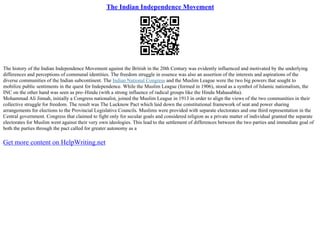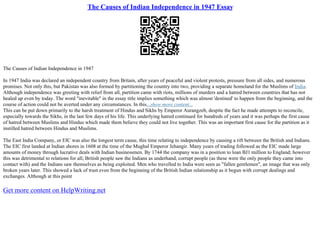WW1 saw millions of Indian volunteers assist Britain in the war, expecting self-government in return, but tensions rose as independence was not granted, fueling the independence movement led by Gandhi and civil disobedience protests against British rule, as India pushed for more autonomy while Britain wanted to maintain control over its colonial possession.





![Socio – Political Situation of India
SOCIO – POLITICAL SITUATION OF INDIA
Any society is a fabrication of diverse regions, cultures, religions, politics and economical overtures. India is a unique land that harbours amorous
people and astounding cultures. As many would accept without doubt it is a RICH nation in every walk of life. Every Indian has something to feel
proud about in its history and riches. It has
в†ђ 5000 year old ancient civilization в†ђ 18 official languages, 325 spoken languages and 1652 dialects в†ђ 30 states and 5 union territories в†ђ
World's largestdemocracy with parliamentary form of government в†ђ 1.3 billion People in an area of 3.28 million sq.kms of which 7,516km is the
coastline в†ђ World's 4th largest economy with GDP of $567 bn...show more content...
LITERACY
[pic]With Kerala at one end and Bihar at the other the table above represent the paradox of India. From 18.33% of literates at Independece, we have
grown to be 64.84% today. This has enormously contributed towards our growth and development. Yet we have another 35% who are still illiterates
and all of them at the rural sector. The largest segment of worlds' illiterates are in India. But an encouraging factor is that the youth (15–24) literacy rate
is at 73.3%.
However our neighbour and competitor China has 98.9% of literacy under the same age group. Even the reduction in the school drop out which was a
major concern in implementing literacy programs is attributed to the famous midday meal scheme in the schools. May be schools are frequented by
many because it fills the stomach more than reaching out to the mind. Apart from the statistics what remains as a disturbing factor is that this growth in
education doesnot usher in the desired change in attitude and mind set of every educated Indian.
POLITICS
After 60 years of Independence with pride we can look back at the shaping of the democratic political system in the country. We are the largest
democratic political system in the whole world with 6 major national parties and innumerable small and approved parties. In spite of the vicissitudes
we have safe guarded the sovereignty of our land. There are more than 50% of the youth today who show great interest in politics compared to the 1990](https://image.slidesharecdn.com/theindianindependencemovement-230630165521-27e9c4a4/85/The-Indian-Independence-Movement-6-320.jpg)














